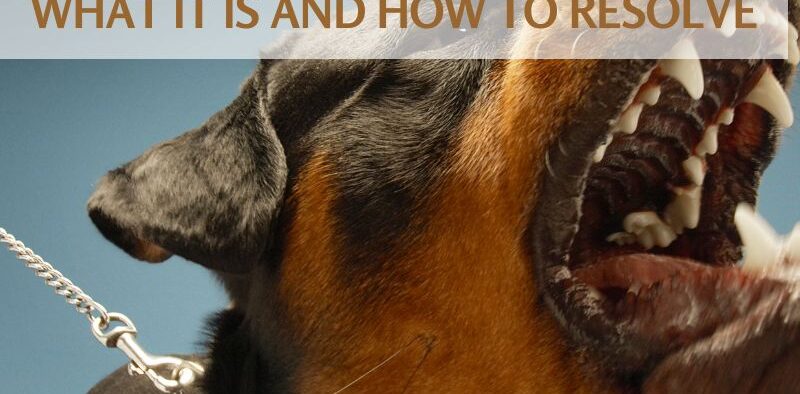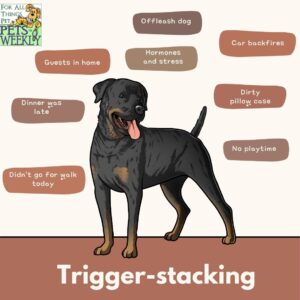Trigger Stacking: Helping Your Dog Cope with Stress Overload
Share

Dogs, as much as we adore them, are not immune to stress, anxiety, and even moments of emotional overwhelm. Just like us, they have experiences that cause them unease or fear. These experiences are referred to as “triggers”. Sometimes, dogs can manage these individual triggers with relative ease. However, there can be times when these triggers seem to pile on, leading to a phenomenon known as trigger stacking.
What Is Trigger Stacking?
Trigger stacking occurs when a dog experiences a series of stressful events in relatively close succession. Think of it like a bucket slowly filling with water – each trigger adds a bit more until the bucket finally overflows. In a dog, this overflow often looks like an extreme reaction, sometimes out of proportion to the final trigger experienced.
For example, a dog walking on a leash might encounter another dog walking towards them (trigger #1). The dog might feel a little tense, but manages. Next, it passes a noisy construction site (trigger #2). The stress increases. Finally, a car backfires (trigger #3). Now that bucket is overflowing! The result could be the dog lunging, barking, or exhibiting other behaviors that seem “over the top” for a simple car backfire.
We most often see this exhibited in high-energy or nervous dogs that haven’t been walked, exercised, trained or mentally stimulated enough. The energy simply builds up in them until they react violently towards you or other dogs, or even inanimate objects (like fences).
A short personal story…
When I was starting out with archery years ago, I once let my bowstring snap back without an arrow nocked. The result was very nearly a $1,500 snapped bow. Why? Because the arrow is the object that absorbs the energy from the drawn bow. Without an arrow to focus the energy outwards, the energy redirects into the bow, snapping it in two. This is one more reason why you should never reach down to grab or hold onto a dog that is already elevated – your dog’s energy will force them to redirect to the nearest thing they can grab, which is usually your hand.
Here’s a diagram that can help you understand your dog’s triggers as they stack on one another (click to fully expand).

Common Triggers for Dogs
It’s important to understand that any experience causing a dog stress, apprehension, or fear can be a trigger. Common triggers include:
- Other animals: Dogs of any size, unfamiliar cats, squirrels, etc.
- Loud noises: Fireworks, thunderstorms, construction, dropped objects
- Unfamiliar people: Especially if they approach unexpectedly or in a perceived threatening manner
- Veterinarian visits: The sights, smells, and procedures
- Changes in routine: New housing, a new family member, moving furniture
- Pain or discomfort: Undiagnosed injuries, illnesses, or just general discomfort can make them more reactive.
- Past traumas: Experiences in puppyhood or before adoption
Each dog is unique and what one dog finds highly stressful might be completely unfazing to another.
Signs of Trigger Stacking and Stress Overload
The key to helping your dog through trigger stacking is spotting the early warning signs. A stressed or anxious dog might exhibit these behaviors: Keep a close eye on your pets for signs of:
- Escalation: Behavior gets worse instead of better as more triggers happen.
- Pacing or Restlessness
- Body language: Stiffening, ears back, tail tucked, wide eyes, yawning
- Excessive Panting
- Licking lips
- Whining or Barking
- “Whale-Eye” (showing excessive whites of the eyes)
- Drooling
- Changes in Appetite:
- Many dogs lose their appetite when stressed.
- Refusal to take treats
- Change in behavior: A once super-friendly dog becoming withdrawn, or a relaxed dog suddenly being reactive.
- Hiding or Cowering
- Destructive Behavior
- Freezing: The dog completely shuts down and refuses to move.
How to Bring a Trigger Stacked Dog Down
Immediate Action (but, Safety First!)
Remove the Trigger (if possible). If you can safely remove your dog from the stressful situation, do so immediately. Taking them to a quiet, familiar space will give them a chance to start calming down. Be careful – a stressed dog could bite in ways they normally wouldn’t.
Don’t Punish, Be Patient
Reacting negatively in the moment will only further increase your dog’s anxiety and add yet another trigger. Remember, their big reaction likely stems from a place of fear, not defiance.
If your dog is in the midst of trigger stacking the most important things are:
Create space: Get them to a quiet, calm area where they can relax. Don’t force interaction. If they want comfort, provide it gently. If not, just being present is soothing. Don’t scold them, this will only worsen the stress.
Consider giving them a chew toy, the act of chewing helps calms pets. Let them be destructive with an old box.
Calming Techniques
- Quiet, familiar space: Give your dog access to their safe spot like a crate or quiet room.
- Comfort items: Offer a favorite toy or blanket with familiar scents.
- Deep pressure: A weighted blanket or a ‘Thundershirt’ can be calming.
- Calm classical music: Studies have shown soft classical music can help alleviate stress for dogs.
- Vet Check: If your dog’s behavior seems out-of-the-ordinary or their response to triggers is extreme, rule out underlying health issues with a vet visit.
Preventing Trigger Stacking
The best way to handle trigger stacking is to prevent it when possible. Here’s how:
- Identify your dog’s triggers: Careful observation is key. Notice what stresses them out and take steps to minimize exposure when possible.
- Gradual desensitization: If the trigger is unavoidable, work with a trainer on gradual exposure and positive counter-conditioning.
- Management: Manage your dog’s environment to prevent unnecessary triggers. This might mean walking at less busy times or avoiding certain places.
Long-Term Strategies to Prevent Trigger Stacking
Identify Your Dog’s Triggers: Keep a log of situations that cause your dog stress. This will help you anticipate and manage stressful situations in the future.
- Management: Wherever possible, avoid putting your dog in situations likely to trigger them or overwhelm them.
- Desensitization and Counterconditioning: If complete avoidance is impossible, work with a qualified dog trainer to gradually desensitize your dog to their triggers, and teach positive associations.
- Consult a Veterinarian or Behaviorist: For severe anxiety or aggression due to trigger stacking, professional guidance might be necessary. They can assess possible underlying causes and suggest medication if needed.
Important Note: If your dog’s reactions are extreme, seemingly unprovoked, or escalating over time, seek the help of a behavior professional. They can assess the situation and develop a personalized plan.
Trigger stacking can be frustrating, but understanding it and working with your dog using patience and positivity can go a long way in improving their well-being and your bond with them. Remember: Patience is Key
Every dog is different; their stress response and recovery time will vary. Be patient, observant, and proactive, and you’ll help your furry companion become more resilient to life’s inevitable bumps and surprises.






